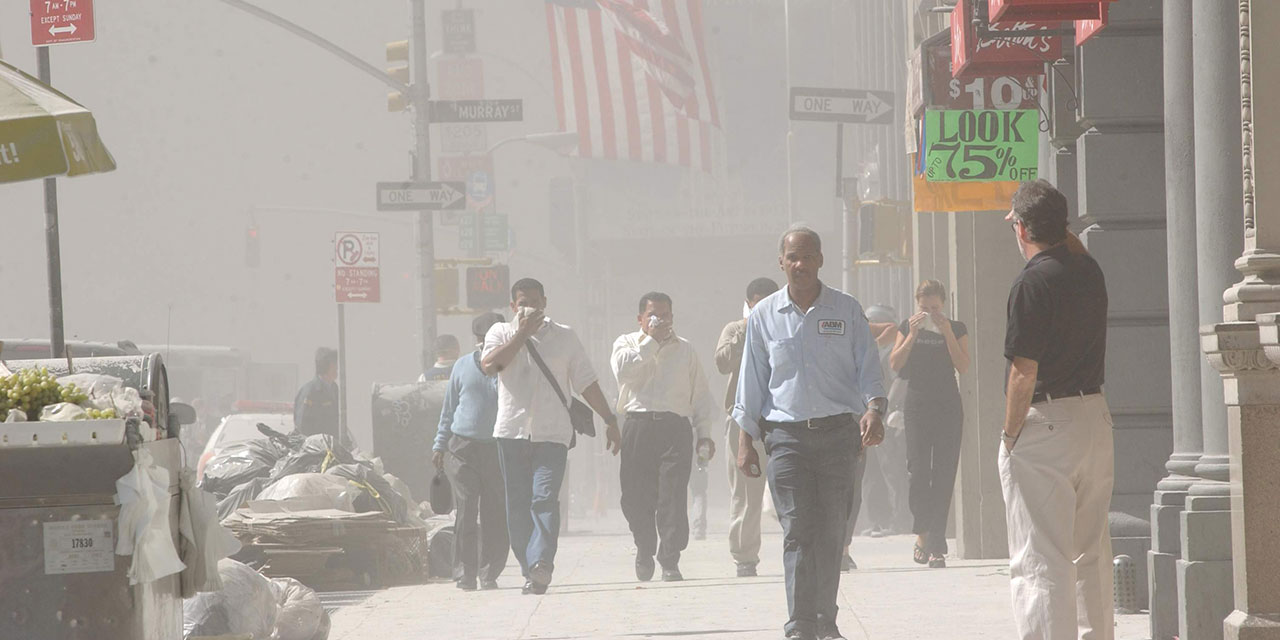
One of the reasons George Santayana’s famous line about forgetting the past resonates is because humans can be so bad at remembering. That’s especially true about the past 25 years of liberal Western democracy. The twenty-first century brand of progressivism that’s corrupted so much Western thinking is all about moving on from a past inevitably deemed regressive. To someone like me, who lived through 9-11 in Manhattan and spent years writing about what we learned from it, the extent to which we have forgotten the lessons of that day and discarded so many of the principles we developed to defend ourselves is shocking.
Just perusing what City Journal published in the weeks after 9-11 is a reminder of how dangerously we as a culture have moved on. One notable story from that time warned about our “leaky borders,” which subsequent investigations would show played a crucial role in enabling the massive conspiracy that culminated in hijacking of four planes. Another piece from 2001 chronicled the rise of something called “militant Islam,” a term derided by some as racist and which prompted President George W. Bush to insist, in response, “Islam is peace.” A third story, the most chilling to read today, though it’s not principally about the U.S., described the rise of an Islamic “fifth column” in the U.K. that was radicalizing British youth. To think that I once worried that that term—fifth column—might be too extreme!
Those three stories represent how clearly we saw the threats back in 2001, and how thoroughly we’ve ignored them since then.
The irony of 9-11 is that it was successful because the bad guys learned their lessons from the past. Many people forget that the 2001 terrorists undertook the second attack on the World Trade Center. The first, eight years earlier, failed to cause widespread damage because the Muslim perpetrators underestimated how many explosives they would need to destroy the foundation of the North Tower. “Only” six people died that day. But what lived on was the idea among terrorists that the World Trade Center represented something fundamental about the West that they hated and wanted to destroy. They just needed to find a more effective way to accomplish their murderous ends.
One of the many differences between Western liberals’ thinking and that of Islamists is that they, as fundamentalists, cherish the past and absorb its lessons. We had our chance to do the same after the 1993 bombing and failed. The weeks and months after that attack were filled with executive orders, presidential directives, new legislation, and promises of international cooperations against terrorism. The Anti-Terrorism Act and Effective Death Penalty Act of 1996 barred terrorists from entering the country, facilitated the deportation of those here, and authorized funds to expand anti-terrorism units within law enforcement. Some of that money was supposed to go to assist coordination and communication among federal and local law enforcement.
Anyone who followed the subsequent investigations into the failures that led to the 9-11 attacks knows that these efforts came to nothing. As Lawrence Wright chronicles in his excellent study, The Looming Tower, turf battles between the CIA and the FBI led the agencies to withhold information from each other about suspicious activity by the conspirators. Intelligence experts and elected officials ignored the larger implications of the bombings of the USS Cole and the U.S. embassy in Nairobi by al-Qaida.
Our immigration policy, meantime, disregarded the threat evident in the 1993 attacks. Instead, the U.S. liberalized visa policy under a Clinton administration that cultivated an attitude of “customer service” toward foreign entrants, enabling the 2001 conspirators to enter and stay here, according to Mark Krikorian’s account in the autumn 2001 issue of City Journal. Among other things, the U.S. embassy in Saudi Arabia instituted an “express visa” program that permitted travel agencies to submit visa requests for applicants without a personal interview by embassy staff. Consular officials around the world were never given adequate training to vet and detect potential terrorists. According to the 9-11 commission, “no agency of the U.S. government” considered vetting visas “as a tool in the counterterrorism arsenal.” If our legal system permitted malpractice lawsuits against elected leaders and government bureaucrats, one could just imagine the size of the judgments in these cases.
And yet, astonishingly, we’ve come through a period in the last four years that makes what happened before the 9-11 attacks seem prudent and responsible by comparison.
It’s not necessary here to rehearse in great detail the shocking recklessness of the Biden administration’s immigration “surge,” through which some 3 million foreigners who appeared at the border seeking asylum or asking for refugee status were admitted to the country, often without vetting, while several million more “getaways” also crossed the border illegally. Most disturbingly, reports of known or suspected terrorists trying to come to the U.S., especially after the Hamas attacks on Israel of October 2023, have soared, according to the FBI. Among the anticrime and antiterrorism programs that the Biden administration suspended for immigrants was testing required by the DNA Fingerprint Act of 2005, a law passed to help law enforcement identify and retain in custody immigrant criminals and other undesirables. While the failings during the 1990s could be attributed to bureaucratic ineptitude, what occurred during the Biden years seems undeniably the product of an administration prepared to undermine the foundations of an American culture it deemed somehow noxious. That’s not so hard to believe once you recognize the anti-Western nature of modern progressivism.
The lack of border security the last four years is all the more troubling because of the rise of a hostile, militant form of Islamism described by Daniel Pipes 24 years ago in City Journal, which gave birth to the 9-11 attacks and was responsible for dozens of others he tracked around the world. In his story, Pipes wrote that Muslims who came to the U.S. faced a choice: to assimilate into our culture, which would allow them to practice their religion while remaining patriotic Americans, or live apart from it. He warned that among Islamists—that is, those who choose to live apart—the debate was not whether they should seek to transform the U.S. into a Muslim nation but whether they should work toward that goal slowly and peacefully, or quickly and violently.
Pipes’s prescient commentary is troubling to read today—and it doesn’t even include the subsequent rise of the Muslim population in Europe enabled by refugee programs in response to ongoing disorder and displacement in the Middle East. That massive immigration would have seemed, in the wake of 9-11, to be unlikely at best, and perilous at worst. We’ve seen its results. The subsequent makeover of British culture, to the point where public officials worry that flying the Union Jack or openly discussing immigrant crimes are provocative acts, suggests how rapidly the clash that Pipes warned of has materialized.
Reading today these stories that City Journal published nearly a quarter century ago, I’m struck by how accurately they reflect the world that was then emerging and has since come to be. Though it was a traumatic time, the consequences that would result from ignorance, naivete, and bad ideas seemed clear enough to discern.
They still are.
Photo by Spencer Platt/Getty Images
City Journal is a publication of the Manhattan Institute for Policy Research (MI), a leading free-market think tank. Are you interested in supporting the magazine? As a 501(c)(3) nonprofit, donations in support of MI and City Journal are fully tax-deductible as provided by law (EIN #13-2912529).

















